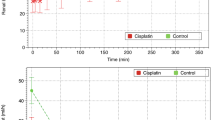Abstract
Aetiologically different models of experimental acute renal failure were induced in rats by the administration of glycerol, mercuric chloride and gentamicin, respectively, to different groups. Quinine levels in plasma and urine of the rats with induced renal failure were determined and pharmacokinetic parameters (eliminationt 1/2, CL p ,V, CLR AUC0–∞) of the drug were derived and compared with values obtained from control rats following intraperitoneal administration of a 10 mg/kg body-weight dose of quinine. Results showed that each of the three compounds caused an up to 25-fold increase in the plasma levels of the drug and a marked decrease in the levels of the metabolite 3-hydroxyquinine. All the pharmacokinetic parameters determined for the rats with renal impairment were markedly different when compared to control. The high plasma quinine levels observed in the rats with renal failure could be largely due to the marked decrease inV and reduced metabolism. Also, in the rats with renal impairment, no correlation was observed between the increased plasma urea levels and plasma quinine levels or disposition of the drug. The results of the study suggest that quinine should be used with caution in patients with renal impairment. The plasma urea levels, as a measure of renal function, might not provide a suitable index for determining quinine dosage.
Similar content being viewed by others
References
Fanke U, Prokesch B, Muller M, Risler T, Ehninger G. Drug monitoring of quinine by HPLC in cerebral malaria with acute renal failure treated with haemofiltration. Eur J Clin Pharmacol 1987;33:293–6.
Donadio JO, Whelton A, Kazyak L. Quinine therapy and peritoneal dialysis in acute renal failure complication malaria haemoglobinuria. Lancet 1968;1:375–9.
Canfield CJ, Miller LH, Bratellani PJ, Eichler P, Barry KC. Acute renal failure inPlasmodium falciparum malaria. Arch Intern Med 1968;122:199–203.
Trenholm GM, William RL, Rieckman LH, Frisher H, Carcon RE. Quinine disposition during malaria and induced fever. Clin Pharmacol Ther 1976;19:459–67.
White NJ, Looareesuwan S, Warrel DA, Warrel MJ, Bunnaq D, Harinasuta T. Quinine pharmacokinetics and toxicity in cerebral and uncomplicated falciparum malaria. Am J Med 1982;73:564–71.
Grossman SH, Davis D, Kitshell DB, Shand DG, Reutledge PA. Diazepam and lidocaine plasma protein binding in renal diseases. Clin Pharmacol Ther 1982;31:350–7.
Mansor SM, Taylor TE, McGrath CS, Edwards G, Ward SA, Wirima JJ, et al. The safety and kinetics of intramuscular quinine in Malawian children with moderately severe falciparum malaria. Trans R Soc Trop Med Hyg 1990;84:482–7.
Berlin CM, Stackman JM, Vessell ES. Quinine induced alterations in drug disposition. Clin Pharmacol Ther 1975;18:670–9.
Mihaly GW, Ching MS, Klein MB, Paul J, Smallwood RA. Differences in the binding of quinine and quinidine to plasma proteins. Br J Clin Pharmacol 1987;24:769–74.
Fremstad D, Sten J, Per KM. Influence of serum protein binding on the pharmacokinetics of quinidine in normal and anuric rats. Acta Pharmacol Toxicol 1977;41:161–76.
Lin JH, Lin T. Renal handling of drugs in renal failure. 1. Differential effects of uranyl-nitrate and glycerol induced acute renal failure in renal excretion of TEAB and PAH in rats. J Pharmacol Exp Ther 1988;246:896–901.
Marsh WH, Fingerhut B, Miller H. Automated and manual direct methods for the determination of blood urea. Clin Chem 1965;11:624–7.
Bolaji OO, Babalola CP, Dixon PAF. Characterization of the principal metabolite of quinine in human urine by H-n.m.r. spectroscopy. Xenobiotica 1991;21:447–70.
Stein JH, Lifschitz MD, Barnes LO. Current concepts on the pathophysiology of acute renal failure. Am J Physiol 1978;234:F171–81.
Smith MW, Ambudkar IS, Phelps PC, Trump BF. Mercuric chloride-induced changes in systosolic Ca2+ of cultured rabbit renal tubular cells. Biochim Biophys Acta 1987;931:130–42.
Silverblatt FJ. Antibiotic nephrotoxicity. Urol Clin North Am 1975;2:557–67.
Kuhar MJ, Mak LL, Lietman PS. Autoradiographic localization of3H gentamicin in the proximal renal tubules of mice. Antimicrob Agents Chemother 1979;15:131–133.
Romero A, Grau A, Gartio A. Ultrastructural study in renal toxicity produced by aminoglycosides. Arch Pharmacol Toxicol 1981;7:25–30.
Barnes JC, McDowell EM, McNeil JS, Flamenbaun W, Trump BF. Studies on the pathophysiology of acute renal failure. IV. Protective effect of dithiothretol following administration of mercuric chloride in the rat. Virchows Arch 1980;B32:201–32.
Trifillis AL, Kahnq MW, Trump BF. Metabolic studies of mercuric chloride-induced acute renal failure in the rat. Exp Mol Pathol 1981;35:14–24.
White NJ, Looareesuwan S, Warrel DA. Quinine and quinidine. EKG comparison in the treatment of falciparum malaria. J Cardiovasc Pharmacol 1983;5:173–5.
Waller D, Krishna S, Craddock C, Brewster D, Jammeh A, Kwiatkoski D, et al. The pharmacokinetic properties of intramuscular quinine in Gambian children with severe falciparum malaria. Trans R Soc Trop Med Hyg 1990;84:488–91.
White NJ. The pharmacokinetics of quinine and quinidine in malaria. Acta Lerdensia 1987;55:65–76.
Silamut K, White NJ, Loouareesuwan S, Warrel DA. Binding of quinine to plasma protein in falciparum malaria. Am J Trop Med Hyg 1985;34:681–6.
Levy G. Pharmacokinetics in renal diseases. Am J Med 1977;62:461–6.
Author information
Authors and Affiliations
Rights and permissions
About this article
Cite this article
Onyeji, C.O., Dixon, P.A.F. & Ugwu, N.C. Disposition of quinine in rats with induced renal failure. Pharmaceutisch Weekblad Scientific Edition 14, 185–190 (1992). https://doi.org/10.1007/BF01962536
Accepted:
Issue Date:
DOI: https://doi.org/10.1007/BF01962536




